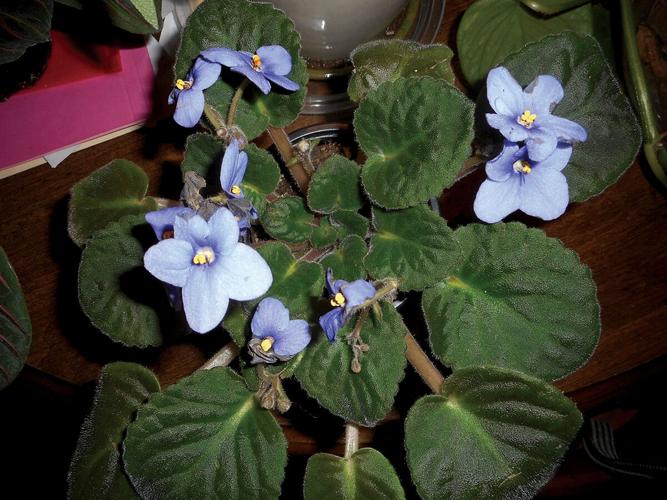You’ve probably seen African violets with their neat rosettes of fuzzy leaves and clusters of purple flowers. Native to Africa, the species were discovered in 1892 by Baron von Saint Paul-Illaire in the mountainous rainforests of Tanzania. Today, there are over 16,000 registered hybridized varieties.
African violets come in miniature (6-inch), semi-miniature (8-inch) and standard (12-inch) sizes. There are even trailing varieties. Flowers can be single or double, with colors ranging from violet and white to pinks, reds and even pale yellows.
Leaves come in solid greens or variegations of green, cream and pink. Leaf edges can be smooth, scalloped or serrated.
Except for trailing varieties, African violet foliage forms a circular rosette around a central crown. Secondary crowns, called suckers, sometimes form and should be removed. As it grows, the sucker will affect the plant’s shape. When small, suckers can be easily removed with tweezers.
If not removed, a sucker can grow large enough to compete with the original crown. A large sucker can be removed intact and potted up to grow into a clone of the original plant.
If the secondary crown is near the soil, it may already have its own roots. To divide the plant, remove it from its pot. Insert a clean, sharp knife between the original crown and the secondary crown and cut through the root ball. Return the original plant to its pot, adding soil as needed and pot up the new plant.
An African violet’s pot should be about one-third the diameter of the leaf rosette. Use a soil mix that is light and airy. You can lighten a standard potting soil by adding coarse perlite in a ratio of two parts potting soil to one part perlite. Some growers mix their own using equal parts peat, perlite and vermiculite.
African violets prefer bright, filtered light and temperatures between 65 and 80 degrees Fahrenheit. They can do well on an east or north windowsill or on a plant stand using grow lights. Place grow lights about 12 inches above standard-sized African violets and 8 inches above miniatures or semi-miniatures.
When the soil feels dry, water from beneath the leaves, giving the soil a good drink. Or fill a saucer and allow the soil to soak up the water. Remove any water that remains in the saucer after 30 minutes. Excess water can lead to root rot.
Fertilize using a flowering houseplant food or African violet food according to package directions.
Unlike most plants, African violets can be propagated from a single leaf. To do so, carefully remove a healthy leaf. Make a clean cut at the bottom of the stem. Prepare a container with moistened potting mix. Make a hole in the soil and place about one inch of the stem in it at a 45-degree angle. Gently press the soil around the stem.
Cover the pot with a plastic bag or an inverted glass jar to retain humidity. Place in indirect light.
Release excess moisture as needed by opening the cover. In 3 – 4 weeks, roots should form and about one month later, tiny leaves will emerge at the base of the stem. When they’re about the size of a dime, the plantlets can be separated and transferred to their own pots.
African violet leaves also can be rooted by placing a leaf, with its stem submerged, in a container of room temperature water. Roots should appear in a few weeks. When they’ve grown more than a quarter inch, the leaf can be planted in potting soil as above.
Deborah J. Benoit is a UVM Extension master gardener from North Adams, Massachusetts.






















(0) comments
Welcome to the discussion.
Log In
Keep it clean. Please avoid obscene, vulgar, lewd, racist or sexual language.
PLEASE TURN OFF YOUR CAPS LOCK.
Don't threaten. Threats of harming another person will not be tolerated.
Be truthful. Don't knowingly lie about anyone or anything.
Be nice. No racism, sexism or any sort of -ism that is degrading to another person.
Be proactive. Use the "Report" link on each comment to let us know of abusive posts.
Share with us. We'd love to hear eyewitness accounts, the history behind an article.